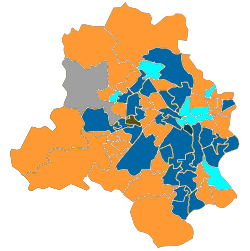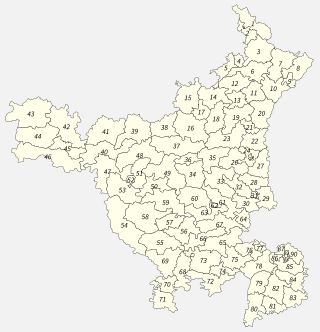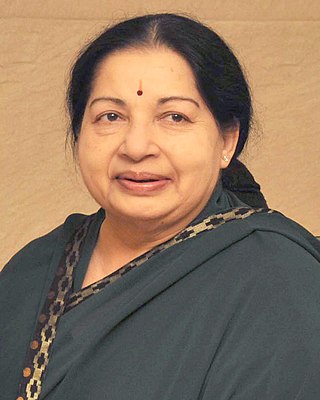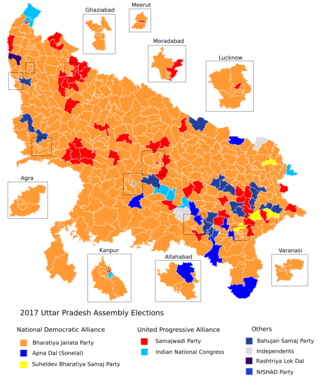
Electronic voting is the standard means of conducting elections using Electronic Voting Machines (EVMs) in India. The system was developed and tested by the state-owned Electronics Corporation of India and Bharat Electronics in the 1990s. They were introduced in Indian elections between 1998 and 2001, in a phased manner. Prior to the introduction of electronic voting, India used paper ballots and manual counting. The paper ballots method was widely criticised because of fraudulent voting and booth capturing, where party loyalists captured booths and stuffed them with pre-filled fake ballots. The printed paper ballots were also more expensive, requiring substantial post-voting resources to count hundreds of millions of individual ballots. Embedded EVM features such as "electronically limiting the rate of casting votes to five per minute", a security "lock-close" feature, an electronic database of "voting signatures and thumb impressions" to confirm the identity of the voter, conducting elections in phases over several weeks while deploying extensive security personnel at each booth have helped reduce electoral fraud and abuse, eliminate booth capturing and create more competitive and fairer elections. Indian EVMs are stand-alone machines built with Write once read many memory. The EVMs are produced with secure manufacturing practices, and by design, are self-contained, battery-powered and lack any networking capability. They do not have any wireless or wired internet components and interface. The M3 version of the EVMs includes the VVPAT system.
Voter verifiable paper audit trail (VVPAT) or verified paper record (VPR) is a method of providing feedback to voters using a ballotless voting system. A VVPAT is intended as an independent verification system for voting machines designed to allow voters to verify that their vote was cast correctly, to detect possible election fraud or malfunction, and to provide a means to audit the stored electronic results. It contains the name of the candidate and symbol of the party/individual candidate. While it has gained in use in the United States compared with ballotless voting systems without it, it looks unlikely to overtake hand-marked ballots.
India has a parliamentary system as defined by its constitution, with power distributed between the central government and the states. India is the largest democracy in the world.

Since its establishment in 1947, Pakistan has had an asymmetric federal government and is a federal parliamentary democratic republic. At the national level, the people of Pakistan elect a bicameral legislature, the Parliament of Pakistan. The parliament consists of a lower house called the National Assembly, which is elected directly, and an upper house called the Senate, whose members are chosen by elected provincial legislators. The head of government, the Prime Minister, is elected by the majority members of the National Assembly and the head of state, the President, is elected by the Electoral College, which consists of both houses of Parliament together with the four provincial assemblies. In addition to the national parliament and the provincial assemblies, Pakistan also has more than five thousand elected local governments.
Rule 49-O was a rule in The Conduct of Elections Rules, 1961 of India, which governs elections in the country. It described the procedure to be followed when a valid voter decides not to cast his vote, and decides to record this fact. The rule was declared by the Supreme Court in September 2013 to be incompatible with the constitution and the Election Commission of India announced that the option under this rule would not be available any more. The apparent purpose of this section was to maintain a proper record in order to prevent the election fraud or the misuse of votes.

General elections were held in India in five phases between 16 April 2009 and 13 May 2009 to elect the members of the fifteenth Lok Sabha. With an electorate of 716 million, it was the largest democratic election in the world until being surpassed by the 2014 general election.

General elections were held in India between 25 October 1951 and 21 February 1952. India attained independence on 15 August 1947 and set up an Election Commission two years later. In March 1950, Sukumar Sen was appointed as the first Chief Election Commissioner. A month later, the Indian Parliament passed the Representation of the People Act which provided the conduct for election for the Houses of Parliament and the Houses of Legislature for each state. It was conducted under the provisions of the Indian Constitution, which was adopted on 26 November 1949. Elections to most of the state legislatures took place simultaneously.
Electronic voting by country varies and may include voting machines in polling places, centralized tallying of paper ballots, and internet voting. Many countries use centralized tallying. Some also use electronic voting machines in polling places. Very few use internet voting. Several countries have tried electronic approaches and stopped because of difficulties or concerns about security and reliability.

There are five types of elections in the United Kingdom: elections to the House of Commons of the United Kingdom, elections to devolved parliaments and assemblies, local elections, mayoral elections, and police and crime commissioner elections. Within each of those categories, there may also be by-elections. Elections are held on Election Day, which is conventionally a Thursday, and under the provisions of the Dissolution and Calling of Parliament Act 2022 the timing of general elections can be held at the discretion of the prime minister during any five-year period. All other types of elections are held after fixed periods, though early elections to the devolved assemblies and parliaments can occur in certain situations. The five electoral systems used are: the single member plurality system (first-past-the-post), the multi-member plurality, the single transferable vote, the additional member system, and the supplementary vote.

The Delhi Legislative Assembly election was held on 4 December 2013, with the result announced on 8 December resulting in formation of the Fifth Legislative Assembly of Delhi.
Legislative Assembly elections were held in the Indian state of Rajasthan on 1 December 2013. Results were announced on 8 December. The incumbent ruling party Indian National Congress, led by the Chief Minister Ashok Gehlot, lost the elections to Vasundhara Raje-led BJP, who was being touted as the next incumbent.

A general election was held on 15 October 2014 to elect 90 members of the Haryana Legislative Assembly. The term of previous assembly elected in 2009 was to expire on 27 October 2014. The results were announced on 19 October. The BJP won the majority in the Assembly. Manohar Lal Khattar was chosen to head the new government.

The Election Commission of India (ECI) is a constitutional body. It was established by the Constitution of India to conduct and regulate elections in the country. Article 324 of the Constitution provides that the power of superintendence, direction, and control of elections to parliament, state legislatures, the office of the president of India, and the office of vice-president of India shall be vested in the election commission. Thus, the Election Commission is an all-India body in the sense that it is common to both the Central government and the state governments.

Noksen Assembly constituency is one of the 60 Legislative Assembly constituencies of Nagaland state in India. It is part of Tuensang District and is reserved for candidates belonging to the Scheduled Tribes.

The Fifteenth Legislative Assembly Election was held on 16 May 2016 for the 232 seats of the Legislative Assembly in the state of Tamil Nadu in India. The AIADMK under J. Jayalalithaa won the elections and became the first ruling party to be re-elected in Tamil Nadu since 1984, though with a simple majority. The DMK won half of the seats it contested but its allies performed poorly; notably, the Indian National Congress won 16% of the seats they contested, and the alliance lost due to its poor performance. The votes were counted on 19 May 2016. In the previous election in 2011, AIADMK, under the leadership of Jayalalithaa, won a thumping majority and formed the government, while DMDK chief Vijayakanth served as the Leader of Opposition until January 2016. This was the last election that J. Jayalalithaa and M. Karunanidhi contested, as they both died in 2016 and 2018 respectively.

The election to the 17th Uttar Pradesh Legislative Assembly was held from 11 February to 8 March 2017 in 7 phases. This election saw a voter turnout of 61.11% compared to 59.40% in the previous election. The Bharatiya Janata Party (BJP) won the election by an overwhelming three-quarters majority of 325 seats despite not projecting a chief ministerial candidate before the election. As part of its election strategy, BJP contested under a collective leadership and capitalised mostly on the political clout and 'brand' of its leader Narendra Modi.
Totaliser is a proposed mechanism in the voting machines in India to hide the booth-wise voting patterns. A totaliser allows the votes cast in about 14 polling booths to be counted together. At present, the votes are tallied booth by booth.

"None of the Above" has been provided as an option to the voters of India in most elections since 2009. By expressing a preference for none of the above, a citizen can choose not to vote for any candidates who are contesting the elections.

The 2021 Assam Legislative Assembly election was the 15th quinquennial legislative assembly election held in the Indian state of Assam from March 27 to April 6 in three phases, to elect 126 MLAs to the 15th Assam Legislative Assembly. The votes were counted and the result declared on Sunday, 2 May. The term of the previous Fourteenth Legislative Assembly of Assam ended on 31 May 2021.
Chief Electoral Officer(India) is a statutory authority created for representing Election Commission of India for conducting elections in states and union territories of India. Constitution of India with introduction of Article 324 made the powers of Chief Electoral Officer(India) independent. Their duties and powers are bound under Section 13 A of Representation of the People Act, 1950 read with Section 20 of Representation of the People Act, 1951.












